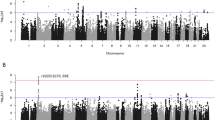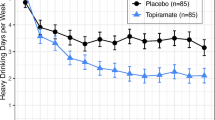Abstract
Various types of alcoholics have been described and heredity has been shown to be involved in some of these types. An important role of the mesolimbic dopamine system has been suggested in the reinforcing effects of alcohol and recent molecular genetic studies are implicating the gene for the D2 dopamine receptor (DRD2) in alcoholism. In a double-blind study, bromocriptine, a DRD2 agonist, or placebo was administered to alcoholics with either the A1 (A1/A1 and A1/A2 genotypes) or only the A2 (A2/A2 genotype) allele of the DRD2 gene. The greatest improvement in craving and anxiety occurred in the bromocriptine-treated A1 alcoholics and attrition was highest in the placebo-treated A1 alcoholics. The feasibility of a pharmacogenetic approach in treating certain types of alcoholics is suggested.
This is a preview of subscription content, access via your institution
Access options
Subscribe to this journal
Receive 12 print issues and online access
$209.00 per year
only $17.42 per issue
Buy this article
- Purchase on Springer Link
- Instant access to full article PDF
Prices may be subject to local taxes which are calculated during checkout
Similar content being viewed by others
References
Koob, G.F. Drugs of abuse: Anatomy, pharmacology and function of reward. Trends Pharmacol. Sci. 13, 177–184 (1992).
Imperato, A. & Di Chiara, G. Preferential stimulation of dopamine release in the nucleus accumbens of freely moving rats by ethanol. J. Pharmacol. Exp. Ther. 239, 219–239 (1986).
Weiss, F., Lorang, M.T., Bloom, F.E. & Koob, G.F. Oral alcohol self-administration stimulates dopamine release in the rat nucleus accumbens: Genetics and motivational determinants. J. Pharmacol. Exp. Ther 267, 250–258 (1993).
Brodie, M.S., Shafner, S.A. & Dunwidde, T.V. Ethanol increases the firing rate of dopamine neurons of the rat. Brain Res. 580, 65–69 (1990).
Blum, K. et al. Allelic association of human dopamine D2 receptor gene in alcoholism. JAMA 263, 2055–2060 (1990).
Cloninger, C.R. D2 dopamine receptor gene is associated but not linked with alcoholism. JAMA 266, 1833–1834 (1991).
Noble, E.P. The D2 dopamine receptor gene: A review of association studies in alcoholism. Behav. Genet. 23, 119–129 (1993).
Pato, C.N., Macciardi, F., Pato, M.T., Verga, M. & Kennedy, H. Review of the putative association of DRD2 and alcoholism. A meta-analysis. Am. J. Hum. Genet. 48, 78–82 (1993).
Uhl, G.R., Blum, K., Noble, E.P. & Smith, S. Substance abuse vulnerability and D2 receptor gene. Trends Neurosci. 16, 83–88 (1993).
Gorwood, P., Ades, J., Feingold, J. Are genes coding for dopamine receptors implicated in alcoholism? Europ. Psychiatry 9, 63–69 (1994).
Cook, C.C.H. & Gurling, H.M.D. The D2 dopamine receptor gene and alcoholism: a genetic effect on the liability for alcoholism. J. Royal Soc. Med. 87, 400–402 (1994).
Gelernter, J., Goldman, D. & Risch, N. The A1 allele of the D2 dopamine receptor gene and alcoholism. JAMA 269, 1673–1677 (1993).
Noble, E.P. & Blum, K. Alcoholism and the D2 receptor gene (letter). JAMA 270, 1547 (1993).
Comings, D.E. et al. The dopamine D2 receptor locus as a modifying gene in neuropsychiatric disorders. JAMA 266, 1793–1800 (1991).
Smith, S.S. et al. Genetic vulnerability to drug abuse: The dopamine D2 receptor TaqIB RFLP is more frequent in polysubstance abusers. Arch. Gen. Psychiat. 49, 723–727 (1992).
Comings, D.E., Muhleman, D., Ahn, C., Gysin, R. & Flanagan, S.D. The dopamine D2 receptor gene: a genetic risk factor in substance abuse. Drug Alc. Depend. 34, 175–180 (1994).
Noble, E.P. et al. Allelic association of the D2 dopamine receptor gene with cocaine dependence. Drug Alcohol. Depend. 33, 271–285 (1993).
Noble, E.P. et al. D2 dopamine receptor gene and cigarette smoking: a reward gene? Medical Hypotheses 42, 257–260 (1994).
Noble, E.P. et al. Allelic association of the human D2 dopamine receptor gene with obesity. Int. J. Eating Disorders 15, 205–217 (1994).
Balldin, J.I., Berggren, U.C. & Lindstedt, G. Neuroendocrine evidence for reduced dopamine receptor sensitivity in alcoholism. Alcoholism 16, 71–74 (1992).
Balldin, J.I., Berggren, U.C. & Lindstedt, G. Further neuroendocrine evidence for reduced dopamine receptor function in alcoholism. Drug. Alcohol. Depend. 32, 159–162 (1993).
Noble, E.P., Blum, K., Ritchie, T., Montgomery, A. & Sheridan, P.J. Allelic association of the D2 dopamine receptor gene with receptor-binding characteristics in alcoholism. Arch. gen. Psychiatry 48, 648–654 (1991).
Noble, E.P., Berman, S.M., Ozkaragoz, T.Z. & Ritchie, T. Prolonged P300 latency in children with the D2 dopamine receptor Al allele. Am. J. Hum. Genet. 54, 658–668 (1994).
Berman, S.M. & Noble, E.P. Reduced visuospatial performance in children with the D2 dopamine receptor A1 allele. Behav. Genet. 25, 45–48 (1995).
Borg, V. Bromocriptine in the prevention of alcohol abuse. Acta Psychiat. scand. 68, 100–111 (1983).
McBride, W.J., Murphy, J.M., Lumeng, L. & Li, T.-K. Serotonin, dopamine and GABA involvement in alcohol drinking of selectively bred rats. Alcohol 7, 199–205 (1990).
Weiss, F., Mitchiner, M., Bloom, F.E. & Koob, G.F. Free-choice responding for ethanol versus water in alcohol preferring (P) and unselected Wistar rats is differentially modified by naloxone, bromocriptine and methysergide. Psychopharmacology 101, 178–186 (1990).
Dyr, W., McBride, W.J., Lumeng, L., Li, T.-K. & Murphy, J.M. Effects of D1 and D2 dopamine receptor agents on ethanol consumption in the high-alcohol-drinking (HAD) lines of rats. Alcohol 10, 207–212 (1993).
Rassnick, S., Pulvirenti, L. & Koob, G.F. SDZ-205,152 a novel dopamine receptor agonist, reduces oral ethanol self-administration in rats. Alcohol 10, 127–132 (1993).
Levy, A.D., Murphy, J.M., McBride, W.J., Lumeng, L. & Li, T.-K. Microinjection of sulphide into the nucleus accumbens increases ethanol drinking in alcohol preferring (P) rats. Alcohol Alcohol., Suppl 1, 417–420 (1991).
Stefanini, E., Frau, M., Garau, M.G., Fadda, F. & Gessa, G.L. Alcohol-preferring rats have fewer dopamine D2 receptors in the limbic area. Alcohol Alcohol. 27, 127–130 (1992).
McBride, W.J., Chernet, E., Dyr, W., Lumeng, L. & Li, T.-K. Densities of dopamine D2 receptors are reduced in CNS regions of alcohol-preferring P rats. Alcohol 10, 387–390 (1993).
Gejman, P.V. et al. No structural mutation in the dopamine D2 receptor gene in alcoholism or schizophrenia. JAMA 271, 204–208 (1994).
Carlsson, C., Johansson, P.R. & Gullberg, B. A double-blind cross-over study: apomorphine/placebo in chronic alcoholics. Intl. J. clin. Pharmacol. Biopharmacy 15, 211–213 (1977).
Borg, V. & Weinholdt, T. A preliminary study of two dopaminergic drags, apomorphine and bromocriptine (ParlodelR), in the treatment of the alcohol-withdrawal syndrome. Curr. Ther. Res. 27, 170–177 (1980).
Morgan, M.Y., Jakobovits, A.W., James, I.M. & Sherlock, S. Successful use of bromocriptine in the treatment of chronic hepatic encephalopathy. Gastroenterology 78, 663–670 (1980).
Feldman, H.S. Apomorphine in the treatment of alcohol addiction: Neurophysiological and therapeutic aspects. Psychiat. J. Univ. Ottawa 8, 30–37 (1983).
Dongier, M., Vachon, L. & Schwartz, G. Bromocriptine in the treatment of alcohol dependence. Alcoholism 15, 970–977 (1991).
Jellinek, E.M. The Disease Concept of Alcoholism (Hillhouse Press, New Haven, Connecticut 1960).
Cloninger, C.R. Neurogenetic adaptive mechanisms in alcoholism. Science 236, 410–416 (1987).
Reese, D.W. Changing patients' health beliefs to improve compliance with alcoholism treatment: A controlled trial. J. Stud. Alcohol 47, 436–439 (1986).
Spielberger, C. Manual for the State-Trait-Anxiety Inventory (Form Y). (Consulting Psychologist Press, Palo Alto, California 1983).
Beck, A.T. Depression Inventory. (Philadelphia Center for Cognitive Therapy, Philadelphia, Pennsylvania, 1978).
Author information
Authors and Affiliations
Additional information
Wolston Park Hospital, Wacol, Australia, 4076
Rights and permissions
About this article
Cite this article
Lawford, B., Young, R., Rowell, J. et al. Bromocriptine in the treatment of alcoholics with the D2 dopamine receptor A1 allele. Nat Med 1, 337–341 (1995). https://doi.org/10.1038/nm0495-337
Received:
Accepted:
Issue Date:
DOI: https://doi.org/10.1038/nm0495-337
This article is cited by
-
Understanding the Scientific Basis of Post-traumatic Stress Disorder (PTSD): Precision Behavioral Management Overrides Stigmatization
Molecular Neurobiology (2019)
-
The dopamine theory of addiction: 40 years of highs and lows
Nature Reviews Neuroscience (2015)
-
Altered regional brain volumes in elderly carriers of a risk variant for drug abuse in the dopamine D2 receptor gene (DRD2)
Brain Imaging and Behavior (2015)
-
Clinically Combating Reward Deficiency Syndrome (RDS) with Dopamine Agonist Therapy as a Paradigm Shift: Dopamine for Dinner?
Molecular Neurobiology (2015)
-
Activation instead of blocking mesolimbic dopaminergic reward circuitry is a preferred modality in the long term treatment of reward deficiency syndrome (RDS): a commentary
Theoretical Biology and Medical Modelling (2008)



